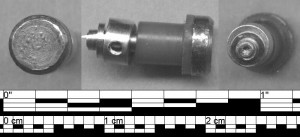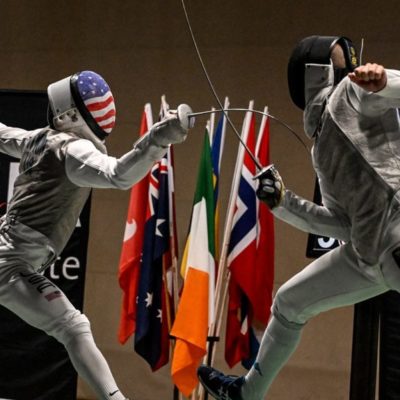Okay—you’re at wit’s end. The problem showed up when you were fencing, but not when you tried to reproduce it on strip during a halt, and you can’t seem to find anything when you checking out the foil later on. You’re tempted to say ‘screw it’ and do a rewire with new point parts, but you’re just a bit too obsessive about wanting to know just what’s going on to let it rest.
That’s pretty much how I felt back when I first encountered the following couple of problems, and was too stubborn to drop an e-mail to more experienced armorers about them. They’re both rather insidious, because they often will only show up under tough fencing (such as when you’re 13-14 in a DE, and there’s a qualification spot or a new classification on the line), and not when you test at the start of the bout. I did finally figure them out on my own. Since I’m not the sort to take an attitude of “by-gone-it, I suffered through it, and you’re gonna too!” (I had enough of that from a graduate-level Classical Electrodynamics course, thank you very much), I’ll go over them for everyone here.
Damaged tip insulation
 This one shows up chiefly on foil tips that don’t have an outer metal sleeve on the tip—that’s to say, Prieur/HPC tips or the basic-model Leon Paul tips. It can also happen with tips that do have metal sleeves (German, Sport 7, Leon Paul Super, Schermasport), but it’s less likely. Just to refresh everyone, the purpose of the plastic insulating sleeve is to keep the head of the tip from grounding to the barrel when the tip is depressed.
This one shows up chiefly on foil tips that don’t have an outer metal sleeve on the tip—that’s to say, Prieur/HPC tips or the basic-model Leon Paul tips. It can also happen with tips that do have metal sleeves (German, Sport 7, Leon Paul Super, Schermasport), but it’s less likely. Just to refresh everyone, the purpose of the plastic insulating sleeve is to keep the head of the tip from grounding to the barrel when the tip is depressed.
Here’s the scenario:
You test spring weight at the start of a pool bout—fine. Then you test valid—fine again. You start fencing. You score a couple of nice, light touches on feint-disengage attacks when your opponent doesn’t pull distance quick enough. Then on an action where your opponent counterattacks with a body evasion and you make a fast line change and a hard hit to the flank, you get no light. You just assume you landed a bit flat and return to the guard lines. You start out with a feint of a flick to the shoulder, your opponent tries to step in, and you finish with a direct thrust that buries the point on the sternum. Only your opponent’s light is on. All right, now you start to suspect something is wrong. After asking the referee, you test just like you did at the beginning of the bout, and get a valid light. The tape over the point is still intact. It’s possible you really did land the point flat before the blade bent, so you keep going. The next action you do the same set-up, draw the same response, make the same finish, and get the same result. Now you finally ask if you can change weapons, but your opponent is up 3-2 when you should have a 5-0 win.
What’s going on?
What’s going on here is that the plastic sleeve on the tip has become worn away or cracked, so that when the point is depressed hard the insulation compresses or separates and allows the metal tip to touch the barrel, which prevents the foil from registering a touch. When you test weight or check valid on an opponent’s lame, you’re typically pushing the tip down rather gently, without enough force to ground the tip through the damaged insulation. That’s why it only shows up in the course of fencing.
If you’re using tips without a metal sleeve, part of your routine pre-tournament inspection of your weapons should be to look closely at the tip insulation, and change the tip if you see any significant damage to it. When testing a foil, it’s a good idea to make a couple of quick, firm hits against a suitable target in addition to just depressing the tip with your fingers and a test weight. Lastly, don’t be timid about asking to change a weapon during a bout if you genuinely suspect it’s not registering correctly (within limits, of course—the ref doesn’t have to let you change, and if you start asking to do so every you land flat…).
Cracked tip shaft
Replay the same bout scenario from above, but have your hits on your opponent’s lame register off-target instead of not at all. All tests on the lame register valid. This isn’t quite as bad as the tip grounding, since your attacks are at least producing an off-target light and have priority over the counterattacks, but it’s still not something you want to have robbing you of touches.
The shaft that the end-flange of the tip is attached to is part of the circuit from the B-line to the head of the tip. A hard, sideways blow to the tip can crack that shaft up in the body of the tip. When the tip is being pushed in gently, the cracked ends of the shaft stay in contact, and you can still register a valid touch. When you deliver a hard hit, especially one that’s not dead straight on and applies some sideways pressure, the crack can separate, which isolates the tip from the B-line and prevents a valid touch being registered.
This one requires a bit more effort than usual to find when testing a weapon. You’ll need to check continuity between just the B-terminal of the guard socket and the head of the tip. It’ll be much easier if you have an alligator-clip lead that can clamp securely to the tip and maintain a good electrical connection while you stress the tip from the side and pull it upwards from the barrel. If you see a break in continuity while doing so, that’s an indication that the shaft is cracked. Remove the tip and check that the end-flange is solidly attached to the shaft. If it is, try twisting the flange and shaft while holding the tip still. If you can feel the shaft turn, then it’s broken and you need to replace the tip.







1 Comment
Comments are closed.